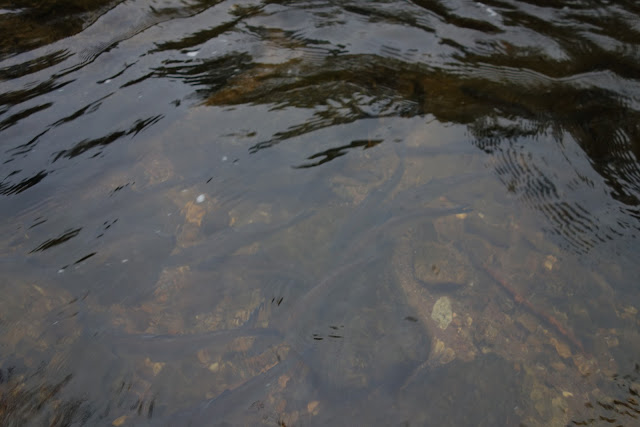Flats fishing has sucked.
Places that have consistently produced good action in years past have been remarkably inconsistent so far this year. Fish uncharacteristically showed up in then left areas where they'd typically be at everyday with good conditions, even through the summer doldrums. Nunzio and I went out on my birthday with a great tide, great wind, the right barometric pressure, and a high sun, and found diddly on the flats. We got our reprieve at a bridge and got a few fish each at the start of the flood, but even that bite wasn't as good as it typically would be that time of year.
The reefs have been decent but sporadic. There are some bigger fish here and there but a lot of really small ones too. The written reports I've seen don't seem to be very realistic based on what I've heard from other anglers, and how I've done out there, but I've come to expect that anyway. Mark and Myron invited me out the day after a pretty good bite, and we had some action, but the fish were clearly responding to pressure. They were very boat shy.
I won't go much into detail on the one bite that is shining bright in Connecticut right now, because, well, it's best if people don't know. Suffice to say, when we got on it it was good enough to convince Rick and I we ought to come back the next morning in the rain looking for more. I didn't really capitalize on the better opportunities that I did get, which is frustrating when such chances are clearly few and far between, but put up decent numbers. I've been most impressed by the number of extremely small bass around. I don't want to catch any more of them, but there sure are a bunch.
Most recently, Mark and I went looking for a topwater big bass bite to do bait-and-switch on, and we didn't find it. But I suspect that fell much more to timing than anything else, we'd not fished that area that early before and didn't really know what to expect. We did find fish, but not the size we wanted or in the place we had intended to focus on. The waning daylight hours were a treat though, featuring one of the best sunsets I've ever seen and a spectacular fireball streaking across a long stretch of sky.
After Mark and I had secured everything on the boat and started walking down the dock at the end of our outing, I did something that pretty well symbolized the present striped bass situation. I, while looking right where I was going, walked right off the edge of the dock into the piss warm, muddy water. My words, upon realizing what I'd just done, were simply "I'm in!".
Towards the edge we continue to walk, looking at all the signs as we go.
Striped bass are not in trouble as a species. But the quality of the fishery is. I hate to sound divisive but if you can't see the problems here, you don't deserve to take part. Seriously. It shouldn't be as hard as it is to come by 30-40 inch striped bass. A productive striper fishery should be loaded with fish of those size. If you feel like you are catching a whole bunch of those size fish and bigger, good for you. You are lucky. You are also in a tiny bubble where those fish are abundant. And they won't be abundant forever. You too will soon be complaining about how bad the fishing is. Fisheries managers are currently taking some steps in the right direction. It is time to step up and light a fire under their butts and make sure every possible advantage is given to striped bass, the fish they eat, and the habitat they require.
If you enjoy what I'm doing here, please share and comment. It is increasingly difficult to maintain this blog under dwindling readership. What best keeps me going so is knowing that I am engaging people and getting them interested in different aspects of fly fishing, the natural world, and art. Follow, like on Facebook, share wherever, comment wherever. Also, consider supporting me on Patreon (link at the top of the bar to the right of your screen, on web version). Every little bit is appreciated! Thank you to my Patrons; Erin, David, john, and Christopher, for supporting this blog.

























































